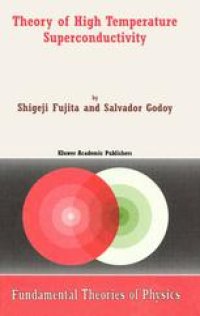
Ebook: Theory of High Temperature Superconductivity
- Tags: Condensed Matter, Physical Chemistry, Statistical Physics
- Series: Fundamental Theories of Physics 121
- Year: 2003
- Publisher: Springer Netherlands
- Edition: 1
- Language: English
- pdf
Flux quantization experiments indicate that the carriers, Cooper pairs (pairons), in the supercurrent have charge magnitude 2e, and that they move independently. Josephson interference in a Superconducting Quantum Int- ference Device (SQUID) shows that the centers of masses (CM) of pairons move as bosons with a linear dispersion relation. Based on this evidence we develop a theory of superconductivity in conventional and mate- als from a unified point of view. Following Bardeen, Cooper and Schrieffer (BCS) we regard the phonon exchange attraction as the cause of superc- ductivity. For cuprate superconductors, however, we take account of both optical- and acoustic-phonon exchange. BCS started with a Hamiltonian containing “electron” and “hole” kinetic energies and a pairing interaction with the phonon variables eliminated. These “electrons” and “holes” were introduced formally in terms of a free-electron model, which we consider unsatisfactory. We define “electrons” and “holes” in terms of the cur- tures of the Fermi surface. “Electrons” (1) and “holes” (2) are different and so they are assigned with different effective masses: Blatt, Schafroth and Butler proposed to explain superconductivity in terms of a Bose-Einstein Condensation (BEC) of electron pairs, each having mass M and a size. The system of free massive bosons, having a quadratic dispersion relation: and moving in three dimensions (3D) undergoes a BEC transition at where is the pair density.
The book describes all basic experimental facts about high temperature superconductivity of materials, with a critical temperature of 30 Kelvin and higher, and explains them microscopically starting with a Hamiltonian followed by step-by-step statistical mechanical calculations. All important theoretical formulas are derived without omitting steps and all basic questions are answered in a manner which is easy to understand. The book is therefore suitable as a textbook for a second-year graduate physics course. Many fresh, and some challenging, ideas are presented and researches in the field are invited to examine the text.
The book describes all basic experimental facts about high temperature superconductivity of materials, with a critical temperature of 30 Kelvin and higher, and explains them microscopically starting with a Hamiltonian followed by step-by-step statistical mechanical calculations. All important theoretical formulas are derived without omitting steps and all basic questions are answered in a manner which is easy to understand. The book is therefore suitable as a textbook for a second-year graduate physics course. Many fresh, and some challenging, ideas are presented and researches in the field are invited to examine the text.
Content:
Front Matter....Pages i-xix
Introduction....Pages 1-18
Superconducting Transition....Pages 19-25
Bloch Electrons....Pages 27-44
Phonon-Exchange Attraction....Pages 45-58
Quantum Statistical Theory....Pages 59-63
Cooper Pairs (Pairons)....Pages 65-76
Superconductors at 0 K....Pages 77-93
Quantum Statistics of Composites....Pages 95-106
Bose-Einstein Condensation....Pages 107-121
The Energy Gap Equations....Pages 123-132
Pairon Energy Gaps. Heat Capacity....Pages 133-146
Quantum Tunneling....Pages 147-161
Flux Quantization....Pages 163-180
Ginzburg-Landau Theory....Pages 181-191
Josephson Effects....Pages 193-206
Compound Superconductors....Pages 207-216
Lattice Structures of Cuprates....Pages 217-225
Out-of-Plane Transport....Pages 227-239
Seebeck Coefficient (Thermopower)....Pages 241-248
Magnetic Susceptibility....Pages 249-258
Infrared Hall Effect....Pages 259-267
d-Wave Cooper Pairs....Pages 269-283
Connection with Other Theories....Pages 285-294
Summary and Remarks....Pages 295-305
Back Matter....Pages 307-310
....Pages 311-323